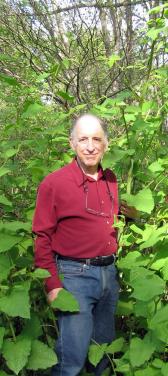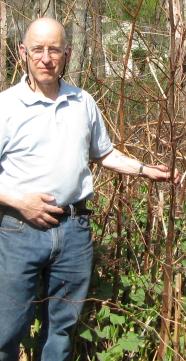
To the left, a May, 2012 picture shows me in a patch of the invasive weed Japanese knotweed. A similar patch played a role in my introduction to the company Kronos. Click on the picture to zoom back for a larger and wider view of the Knotweed patch. As one would expect when establishing oneself in a new job, and particularly at a startup, I worked rather hard in my early days at Kronos. My title was "Chief Engineer", and I had a corner office in our third-floor walk-up above the Auciello Iron Works in Allston, Massachusetts. Since my office was right off the main lobby, I frequently closed my door in order to work undisturbed. The story of my arrival at Kronos, and particularly about an urgent problem that I needed to confront immediately, is told in my earlier blog entry Coming to Kronos. Engineer that I was, and with urgent tasks to accomplish, I initially paid less attention to developing a relationship with employees that I didn't interact with directly.
The full photo is shown at the bottom of the same blog entry I mentioned above, Coming to Kronos (if you go there, scroll to the bottom). Vicky's image, with me alongside her, cut out of that photo, can be seen to the right, but it's a rather low resolution image. Looking back at that photo, I suspect that another thing Vicki might have found to be odd was that I dressed a bit more formally than most of the other people at Kronos, tending to wear a tie to work. The company was generally extremely informal in dress. The president, Mark Ain, only wore a tie under duress, if he had to visit with bankers to ask for money. Employees occasionally ate lunch at various nearby restaurants, and one day, after I'd been there a week or so, Vicky knocked on my door, and invited me to accompany a group. They were going to a nearby motel within walking distance along Soldiers Field Road, and eating at the restaurant there. I think it was a Ramada Inn, but I may not be remembering correctly. Along the way, we passed a patch of Japanese knotweed growing alongside the road (a typical location for it). I broke off a long stalk, carried it with me, and chatted about the plant as we walked (in my general mode of offering people more information than they are really interested in - see my blog entry Lobster). Vicky later said she was surprised to find me so voluble and sociable, since she had previously taken my closed office door as an indication that I was somewhat of a loner. I had picked a reasonably large stalk of the plant, but since it was only mid April, much of the rest of the Knotweed patch was just beginning to sprout. I came back the next day, and harvested a number of these young, tender stalks. Following a recipe in the Euell Gibbons book Stalking the Wild Asparagus, I cooked up a sauce, which had a tart taste similar to a rhubarb sauce. I brought it into the office, along with a quart of vanilla ice cream, and served it up to the staff (at least, to those who were willing to give it a try). This episode was the beginning of my getting acquainted on a more personal level with Vicky and a number of other members of the staff.
Obviously, the town of Wayland can't be too happy about this, since it's already started to break up the pavement (click on the photo to see another such sprout, even larger). A little searching on the web shows that Japanese knotweed is not limited to the United States. As the name implies, it's found in Japan, and in fact in many parts of eastern Asia. It was brought to the US as an ornamental plant, and escaped. If you want to learn more, check out its Wikipedia page. A website called Galloway Wild Foods (subtitled, "Foraging in Scotland's Bountiful Southwest") has a page on Japanese knotweed. It includes, under the title IMPORTANT HARVESTING NOTES:
Japanese knotweed goes by the Latin name Fallopia japonica (it seems to also be called Polygonum cuspidatum). It's included on the Wikipedia site List of the World's 100 Most Invasive Species (which includes animals as well as plants). Although I've only known it by one name, that site lists a total of sixteen common names: "crimson beauty, donkey rhubarb, fleeceflower, German sausage, huzhang, itadori, Japanese bamboo, Japanese fleece flower, Japanese knotweed, Japanese polygonum, kontiki bamboo, Mexican-bamboo, peashooter plant, renouée du Japon, reynoutria fleece flower, and sally rhubarb". I've previously mentioned it as an invasive species in my blog entry called Horseradish. I can't find my copy of the Euell Gibbons book Stalking the Wild Asparagus. But from the Foraging Foodie website (April 2019 note: now defunct), here's a recipe for a sauce similar to the one that I made 35 years ago for the employees of Kronos:
  |

 Although I didn't realize it until later, with my closed door, I was apparently viewed as somewhat mysterious by our sociable office manager and administrative assistant Vicky Ramsey. The only image I can find of Vicky after all these years is in the 1979 photo of most of the employees of Kronos shipping our first production timeclocks late that year.
Although I didn't realize it until later, with my closed door, I was apparently viewed as somewhat mysterious by our sociable office manager and administrative assistant Vicky Ramsey. The only image I can find of Vicky after all these years is in the 1979 photo of most of the employees of Kronos shipping our first production timeclocks late that year.

